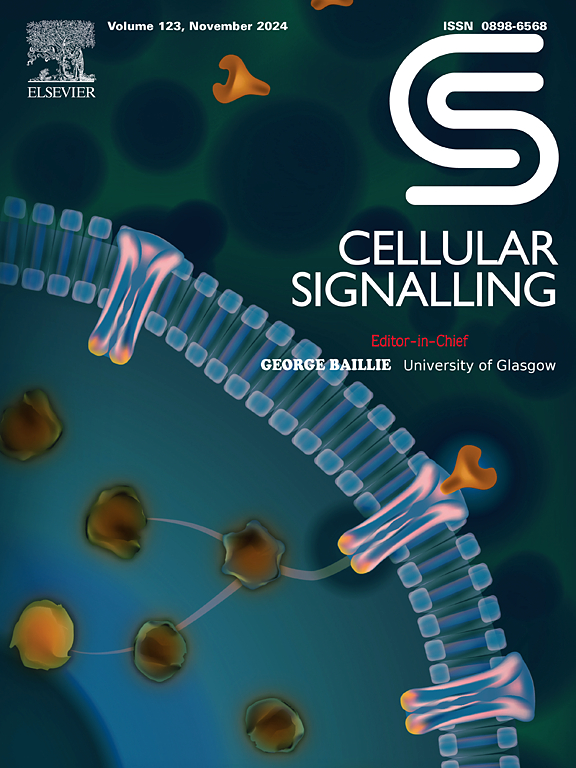PKA restricts ERK signaling in learning and memory Kenyon cell neurons
IF 4.4
2区 生物学
Q2 CELL BIOLOGY
引用次数: 0
Abstract
Protein Kinase A (PKA) and Extracellular Signal-Regulated Kinase (ERK) have core roles in learning and memory. Here, we investigate kinase-kinase signaling interactions in the Drosophila brain Kenyon cell learning/memory circuit using separation of phases-based activity reporter of kinase (SPARK) biosensors to image circuit-localized functions in vivo. We find that constitutively active Rapidly Accelerated Fibrosarcoma (RAFgof) enhances ERK signaling only in Kenyon cell domains with low baseline PKA signaling, and that transgenic inhibition of PKA function elevates ERK signaling. Conversely, loss of ERK has no impact on PKA signaling, whereas RAFgof expands PKA signaling. Importantly, transgenic PKA inhibition together with RAFgof synergistically elevates ERK signaling. These findings indicate a negative PKA-ERK pathway interaction within learning/memory Kenyon cells. We find that potentiating circuit activity using an exogenous NaChBac ion channel elevates PKA signaling in circuit domains with low baseline PKA function, and uniformly strongly increases ERK signaling. Similarly, thermogenetic stimulation of circuit activity with a temperature-sensitive TRPA1 channel increases PKA signaling in circuit domains of low baseline PKA, and elevates ERK signaling. Importantly, potentiating circuit activity (NaChBac) while also inhibiting PKA function synergistically elevates ERK signaling. Likewise, conditional induction of circuit activity (TRPA1) together with PKA inhibition increases activity-dependent ERK signaling. Finally, a mechanically-induced seizure model (bang-sensitive sesB mutant) elevates PKA signaling, while simultaneous transgenic PKA inhibition in this model acts to synergistically increase ERK signaling. Taken together, we conclude PKA limits ERK signaling in Kenyon cells within the learning and memory circuit, with PKA function acting to restrict activity-dependent ERK signaling.
PKA 限制学习和记忆凯尼恩细胞神经元中的 ERK 信号传导
蛋白激酶A (PKA)和细胞外信号调节激酶(ERK)在学习和记忆中起着核心作用。在这里,我们研究了在果蝇大脑Kenyon细胞学习/记忆回路中激酶-激酶信号相互作用,使用基于相位的激酶活性报告(SPARK)生物传感器分离来成像回路定位功能。我们发现组成型活性快速加速纤维肉瘤(RAFgof)仅在具有低基线PKA信号传导的Kenyon细胞结构域增强ERK信号传导,而转基因抑制PKA功能可提高ERK信号传导。相反,ERK的缺失对PKA信号传导没有影响,而RAFgof则扩展了PKA信号传导。重要的是,转基因PKA抑制与RAFgof协同提升ERK信号。这些发现表明在学习/记忆Kenyon细胞中PKA-ERK通路负相互作用。我们发现,使用外源性NaChBac离子通道增强电路活动可提高PKA信号在低基线PKA功能的电路域中的信号,并一致地强烈增加ERK信号。同样,通过温度敏感的TRPA1通道对电路活动进行热刺激,会增加低基线PKA电路域中的PKA信号,并提高ERK信号。重要的是,增强电路活性(NaChBac)同时抑制PKA功能协同提升ERK信号。同样,电路活性的条件诱导(TRPA1)和PKA抑制增加了活性依赖的ERK信号。最后,机械诱导的癫痫模型(bang-sensitive sesB突变体)会升高PKA信号,而在该模型中,转基因PKA抑制同时会协同增加ERK信号。综上所述,我们得出结论,PKA限制了学习和记忆回路中Kenyon细胞中的ERK信号传导,PKA功能限制了活动依赖性ERK信号传导。
本文章由计算机程序翻译,如有差异,请以英文原文为准。
求助全文
约1分钟内获得全文
求助全文
来源期刊

Cellular signalling
生物-细胞生物学
CiteScore
8.40
自引率
0.00%
发文量
250
审稿时长
27 days
期刊介绍:
Cellular Signalling publishes original research describing fundamental and clinical findings on the mechanisms, actions and structural components of cellular signalling systems in vitro and in vivo.
Cellular Signalling aims at full length research papers defining signalling systems ranging from microorganisms to cells, tissues and higher organisms.
 求助内容:
求助内容: 应助结果提醒方式:
应助结果提醒方式:


